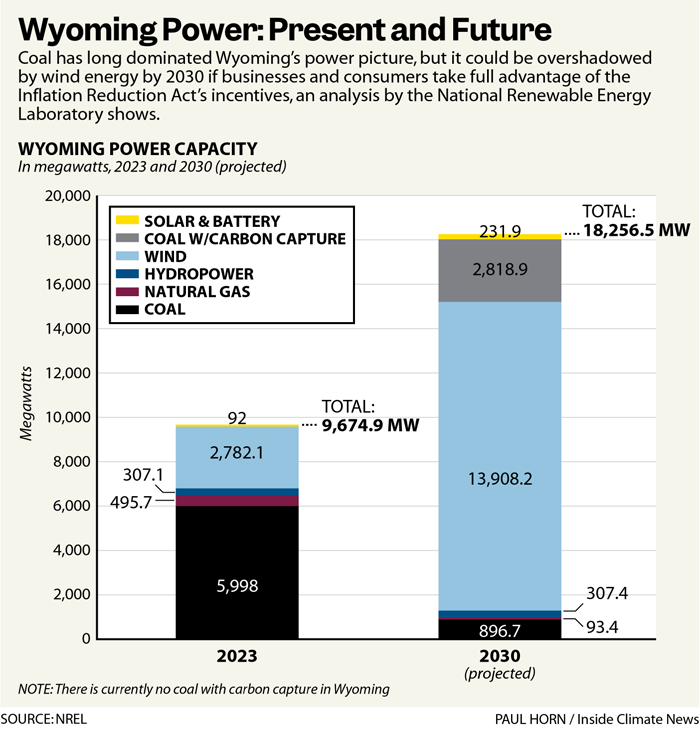Wyoming Could Gain the Most from Federal Climate Funding, But Obstacles Are Many
Wyoming Senators John Barrasso and Cynthia Lummis, leading Republican voices on energy policy, have been among the foremost critics of the nation’s first comprehensive climate law.
Barrasso has called the Inflation Reduction Act, or IRA, the Democrats’ “reckless green spending spree,” while Lummis derided its “unrealistic measures to cut carbon emissions.”
But earlier this summer, Barrasso and Lummis co-hosted what they billed as a first-of-its-kind “federal funding summit” to help train Wyoming communities and organizations to apply for the new funds available under bipartisan infrastructure legislation and the IRA’s unprecedented $370 billion federal investment in the clean energy transition.
In a press release announcing the four-day session, the senators acknowledged that they had opposed the bills, but said “both senators are committed to ensuring Wyoming communities and citizens have fair access to the programs their tax dollars are helping to fund.”
Wyoming, the nation’s top coal-producing state,second only to Texas as a net energy supplier, finds itself in a unique position under the incentives-driven climate policy that President Joe Biden succeeded in getting through Congress one year ago.
If the United States acts aggressively enough to meet its commitments under the Paris climate agreement, Wyoming has the potential to reap more than $7 billion from the climate-related provisions of the IRA, according to an analysis by the think tank RMI, formerly known as the Rocky Mountain Institute.
That would work out to more than $12,000 per person in Wyoming—greater potential per capita benefits than any other state.
Wyoming could take advantage of numerous provisions in the law designed to assist fossil fuel-dependent communities while tapping into some of the best wind energy resources in the country, which roll off its mountain ranges and across its vast expanses of ranchland.
But there are obstacles to Wyoming making a rapid, federally-funded transition from fossil fuel giant to national leader in carbon-free energy. The Barrasso-Lummis summit was meant to address one of those barriers—the rural state’s lack of capacity and experience in competing for big federal dollars. Other hurdles may be more difficult to overcome, including local resistance to renewable energy growth and the state’s deep commitment to coal, oil and gas—and the tax revenue they generate.

Wyoming Gov. Mark Gordon, a Republican who hosted the federal funding summit along with Barrasso and Lummis, has welcomed clean energy technologies as an addition to—not a replacement for—the state’s traditional energy sources. Fossil fuels are “a vital component of any effort to successfully address reasonable climate goals,” he said earlier this year.
Gordon’s office would not comment on RMI’s projection of the potential windfall for Wyoming in the IRA. “We find the methodology to be speculative and flawed, as there are many factors that will determine whether or not Wyoming may benefit from potential funding/incentives from the IRA,” said his spokeswoman, Ivy McGowan-Castleberry, in an email.
New Opportunities in Wind, Nuclear and Carbon Capture
Most of Wyoming has a competitive advantage in attracting clean energy development projects and associated federal funding under the IRA. The Biden administration’s mapping delineates nearly all the state as within an “energy community” zone, either adjacent to a former coal mining or power plant site or reliant on fossil fuels for jobs and tax revenue.
Clean energy projects that locate in energy communities are eligible for a 10 percent bonus to the federal clean electricity investment tax credits, which cover 30 percent of project costs. Further bonuses are available for projects that include apprenticeship programs, rely on domestic content for raw materials and aid low-income communities.
RMI senior associate Ashna Aggarwal, who worked on the think tank’s state-by-state analysis on the potential impacts of the IRA, said more than half of the benefits that could flow to Wyoming are from the clean electricity investment tax credits. That analysis takes into account the state’s substantial wind energy resources as measured by the National Renewable Energy Laboratory. NREL projects that wind power capacity could expand five-fold by 2030 in Wyoming if the state takes full advantage of the incentives available in the IRA.
“Wyoming is really well-poised to take advantage of clean resources that they have in the state, like wind, and Wyoming is already taking action,” said Aggarwal.
She points to the 3,500 megawatt Chokecherry and Sierra Madre Wind Energy Project now under construction near Rawlins in southern Wyoming, set to be the largest wind farm in the United States. Once it begins operations in 2027, its power will flow to Nevada, Arizona and California via the 732-mile TransWest Express high-voltage transmission line, which is also under construction, after receiving final approval from the Biden administration earlier this year.
Another IRA provision that could be important to Wyoming is the new Energy Infrastructure Reinvestment Program, expected to roll out next year, offering support to projects that seek to “retool, repower, repurpose or replace” existing energy infrastructure. Unlike other federal clean electricity loan programs, the EIR program will not require projects to use innovative technology; they can be eligible as long as they reduce greenhouse gas emissions and reinvest in the affected community.
The idea of retooling legacy energy sites had taken hold already in Wyoming before the IRA’s passage, with Microsoft billionaire Bill Gates’ company, TerraPower, selecting an old coal plant site in Kemmerer as the location for his liquid sodium-cooled Natrium advanced nuclear energy demonstration project. After the IRA’s passage, TerraPower and its partner, the utility PacifiCorp, announced that they would study deploying up to five additional commercial Natrium reactors and integrated energy storage systems, including the possibility of locating them near current fossil fuel sites.
And carbon capture, which Gordon and other Wyoming politicians have long seen as the hope for maintaining coal’s future in the state, also could get a boost from the IRA. Utilities have viewed the technology as too expensive, but the IRA could ease the costs by greatly increasing the value of the tax credits available for carbon capture and utilization (for enhanced oil recovery, for example) or sequestration. A test case could be the direct air capture carbon removal project, Project Bison, announced after passage of the IRA and being constructed in Rock Springs near a coal plant that is currently switching over to natural gas. Meanwhile, the University of Wyoming has been tapped to receive the largest of nine federal grants to develop carbon storage hubs across the country.
Nathan Wendt, president of the Jackson Hole Center for Global Affairs, a non-partisan think tank focused on engaging energy communities in the clean energy transition, said he sees great interest across the state in the new opportunities offered by the IRA.
“We might have some of the best energy workers in the world and a lot of the necessary energy infrastructure,” Wendt said. “Wyoming wants to continue to remain a leader in energy production. And I think that they see the great opportunity to do so by, you know, chasing as aggressively as they can the clean energy opportunities that are really now turbocharged because of the inflation Reduction Act.”
Community Concerns About Wind Power, Harm to Ecosystems
But there have been obstacles to the clean energy build-out in Wyoming, as is clear from the fact that the state is not now among the top 10 wind energy producers, despite the extraordinary resources that whip across its landscape as air flows from higher to lower elevations.
Because Wyoming—the nation’s least populous state—produces nearly 12 times more energy than it consumes, any new energy generation projects have to be able to move power outside the state to population centers. And because the state is located on the eastern end of the nation’s western electric grid, that means putting transmission lines over hundreds of miles of federal land to Western population centers. It took 18 years for the TransWest Express line, which is crucial to the viability of the Chokecherry/Sierra Madre wind project, to get all of the needed approvals before the groundbreaking this year. The debt ceiling legislation Congress passed this summer included new deadlines for environmental reviews of such projects; it remains to be seen whether they will substantially speed the permitting process.
Some clean energy projects have faced opposition in Wyoming, including a 504-megawatt wind project near Laramie where local landowners waged a years-long fight before their defeat before the state Supreme Court earlier this year.
“People really like the long views we have in Wyoming,” said Jonathan Naughton, director of the Wind Energy Research Center at the University of Wyoming. “It’s big sky country and you can see the horizon, so you can see turbines that are 50 miles away.”
At the same time, Naughton said, local economies see benefits from wind development, with landowners earning substantial royalties for turbines located on their properties. That’s revenue that allows them to weather ups and downs in the agricultural markets, and avoid subdividing and selling off their land. “Part of the agricultural community really embraces wind energy because it allows them to keep those big ranches intact,” he said.
Another issue on which there is continuing scientific study and debate is how to accelerate the build-out of wind energy while protecting the fragile sagebrush ecosystem of Wyoming, and the species that rely on it, including the iconic sage grouse.
“I think people look at Wyoming from the outside, and they’re like, ‘Oh, small population, lots of land, lots of space, the perfect place to put the large-scale renewable energy build-out that our country, frankly, needs,” said Monika Leininger, director of external affairs and climate policy at The Nature Conservancy. “What I don’t think people always understand is the sensitivity of the landscapes we have.”
The Nature Conservancy has an initiative to encourage siting renewable energy on the previously disturbed land in Wyoming—often, former fossil fuel sites—to avoid breaking new ground.
“We think there is enough room for wind and solar and wildlife and our landscapes to thrive,” she said. “I think it’s going to depend on how well utilities can work together to plan and utilize existing rights-of-way for transmission and think about the best way to share resources.”
No Income Taxes, But Lots of Fossil Fuel Revenue
But Wyoming’s Republican leaders do not talk about clean energy as a replacement for fossil fuels. With no state income tax, Wyoming is heavily dependent on severance taxes and other fossil fuel revenue to fund its state government.
Wyoming does levy an excise tax on wind energy production in the state, but it does not begin to approach the revenue generated by coal, oil and natural gas. A study last year by University of Wyoming researchers estimated that with aggressive growth of wind energy in the state, wind production tax revenues could increase to $89 million per year. But Wyoming currently expects to bring in $744.3 million in mineral severance tax revenue over its two-year 2023-2024 budget period. With another $597 million expected in federal mineral royalties, fossil fuel revenue will make up about 40 percent of Wyoming’s expected $3.5 billion in revenue.
Although the state legislature has repeatedly considered raising the wind energy tax, lawmakers concluded that such a hike would cause Wyoming to lose wind development to other states.
Wyoming doesn’t have a renewable energy portfolio standard, the kind of policy that has driven an increase in wind and solar development in other states. And the state puts limits on net metering—payments to rooftop solar owners for the excess power they sell back to the grid—in a way that could hinder the kind of community solar projects supported by the IRA.
But Rob Joyce, organizer for Sierra Club in Wyoming, said there are positive signs, including indications that Wyoming will apply for a climate pollution reduction grant from the U.S. Environmental Protection Agency, and that the state is pursuing energy efficiency rebate programs. Such small steps alone show the state has come a long way.
“It’s been a little bit tenuous to have these conversations—even the idea of taking federal money is an issue in some parts of our state, and certainly at our state legislature,” Joyce said. “But I think the majority of people in Wyoming, even the people who are in those positions of power, recognize the opportunity here. We’re maybe not moving as quickly as we would like to, but we’re certainly not at a standstill here.”
Disclaimer: The copyright of this article belongs to the original author. Reposting this article is solely for the purpose of information dissemination and does not constitute any investment advice. If there is any infringement, please contact us immediately. We will make corrections or deletions as necessary. Thank you.







